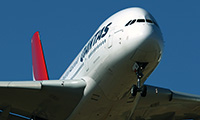News
Turbulence to end?
Qantas Airways announced a $2.6 billion annual loss last month, the biggest deficit in Australian aviation history. But the flag carrier insists it is through the worst.
September 1st 2014
If Qantas Airways chief executive, Alan Joyce, had any misgivings about announcing the company’s massive after tax loss for the latest financial year, he did not show it. Read More »
 |
| 'Given the amount of partners that we have around the globe, the interest there is in the Australian market and the attractiveness of this brand name, there is not going be a shortage of people interested in the company' |
| Alan Joyce CEO Qantas |
Indeed, there was little sign he was under any pressure at all. In what may be the year’s biggest airline results understatement, he declared there was no doubt the numbers were “confronting”. Indeed.
Joyce, who is taking a 40% cut in his pay this year, argued the numbers may be big, but they represent the year that is past. “We have come through the worst. There is a clear and significant of easing of international and domestic capacity growth that will stabilize the revenue environment.
“We expect a rapid improvement in the Group’s financial performance and a return to Underlying Profit Before Tax profit in the first half of fiscal year 2015, subject to factors outside our control,” he said.
Qantas, said Joyce, with its accelerated $1.87 billion transformation program well under way, is already emerging as a leaner, more focused and more sustainable airline group.
While the airline’s unions reacted promptly to the news, complaining the carrier had a board full of people with no airline experience and that Joyce has been saying the worst is over for the past four years, there were several reasons to support the view that the result is not as bad as it looks on paper.
Its fuel bill increased $236.3 million to $4.2 billion. Losses at its long haul international arm worsened, from $229.7 million in the 2013 year to $464.1 million in the latest twelve months.
Fuel expenditure and foreign currency movements hit Qantas International hardest of any of the group’s businesses, costing the carrier $132.9 million. The group also emerged bruised from a domestic price war with Virgin Australia.
Redundancy packages cost $400.6 million and early aircraft retirements $368.7 million. Since the decision to remove 5,000 jobs from the staff was announced last February, 2,500 employees have left Qantas.
Joyce has led a $2.4 billion write-down of the group, after a company restructure that included a revaluation of its fleet. Some of Qantas’s airliners were purchased when the A$ was worth below 60 U.S. cents. The current exchange rate is around 93 U.S. cents. All this bad news distracted attention from a better-than-expected underlying loss, before tax, of $604.6 million, compared with a $174 million profit a year earlier.
Qantas’s Asian Jetstar budget subsidiaries turned in a deteriorating performance, with a combined loss of $65.4 million, almost $19 million higher than a year earlier. The red ink included start-up costs at Jetstar Japan and a $40 million deficit at Jetstar Asia in Singapore, which Joyce said was a result of a significant capacity increase in the market.
“That has resulted in all carriers in Southeast Asia losing money. Tigerair’s losses were significant. AirAsia X had significant losses. But we are seeing an alleviation of that capacity situation. I would point out that Jetstar Singapore has been profitable for the previous four years. Going forward, we are optimistic, with capacity rationalizing,” said Joyce.
Nevertheless, he said that in the world’s fastest growing aviation market, Southeast Asia remained “a major long-term opportunity that we continue to believe in”. “No new Jetstar ventures will be established while the Group is focused on transformation, “but we know that substantial value exists across the Jetstar airlines and we will realise that value over time”, he said.
Not all the news was bad. The domestic operations of Qantas made a $30 million profit. Joyce said despite current losses, Qantas International is transforming at speed, with $400 million in costs removed from the carrier in the past two years.
Qantas’ frequent flyer program recorded its fifth straight year of double-digit growth, delivering a $267.7 million profit, up from $243.3 million a year earlier. Joyce also announced the loyalty program will not be sold, as had been rumoured, for some time. He said the company had identified other potential asset sales, including airport terminals and property and land holdings. Any proceeds from such sales would be used to repay debt.
Qantas finished the year with a strong cash position of $2.8 billion and total liquidity of $3.4 billion. It needs no major unsecured re-financing before April 2016. The restructuring also delivered $411.8 million in benefits during the past year, with another $842.3 million in initiatives underway and $561.5 million in savings expected to be achieved in the current financial year.
“The reality is we are undergoing the biggest and fastest transition since the privatization of Qantas in 1995,” said Joyce. “Our transformation is about working our assets harder, making our business smarter, giving even more to our customers, and reshaping our operations for long-term sustainable success. We are only six months into the program, but we front-loaded many of the more difficult employment and restructuring measures, so we are well ahead in terms of the execution of our major plans.”
Joyce announced the creation of a new holding structure and corporate entity for Qantas International that has resulted from the recently passed changes to the Qantas Sale Act (QSA). The amended legislation retains the 49% foreign ownership cap but the limits on equity held by foreign carriers up to 49% have been removed.
 |
Theoretically, a single foreign carrier can now own 49% of Qantas, but that prospect is problematic because the airline is already 38% owned by foreign investors, none of which are airlines. As a result foreign carriers cannot buy more than 11% of Qantas at present, unless existing offshore shareholders sell, or Qantas issues additional shares. Qantas has been fighting for years to have the QSA abolished altogether, complaining it creates an uneven playing field because its major competitor, Virgin Australia isn’t governed by such regulations. Virgin Australia Holdings, through a clever corporate structure, is 80% owned by Singapore Airlines, Air New Zealand, Etihad Airways and the Virgin Group in the UK. The combined clout of the owner airlines gives Virgin Australia access to foreign funding and loan packages not available to Qantas.
Joyce did not outline the new structure, but said it would have no impact on Qantas International’s day-to-day operations, network or staffing. “However, this structure will create the long-term option for Qantas International to participate in partnership opportunities in the international aviation market, with a view to achieving more efficiencies and improved returns to shareholders,” Joyce said.
Joyce also clarified the carrier’s fleet strategy, which will complete the retirement of older aircraft types and will be “increasing fleet utilization in international and domestic markets, putting the right aircraft on the right route, offering the best experience in every market for customers and realising the cost benefits of new-generation aircraft”, he said.
Of the $1.87 billion in savings $561.5 million will come from fleet and network initiatives. Key fleet and network changes completed or announced included a 5% plus increase in asset utilisation by Qantas International, gradual replacement of B747s with A330s on routes to Asia and early retirement of four B747-400s.
In the past year Qantas took delivery of 23 new aircraft, retired 19 and returned eight leases. Under plans for the current fiscal year, it will accept delivery of 10 new aircraft, retire 18 and return two leases. The mainline fleet will be reduced from 11 different types in 2013 to seven aircraft types in two years.
Fifty aircraft on order will be deferred or sold to reflect more efficient fleet utilisation and slower capacity growth. This will include pushing back the first of its 50 B787 options and purchase rights from 2016 to 2017 and deferring the final eight A380s on order for Qantas International. Delivery dates will be under review to meet potential requirements.
Qantas’ priority is to push forward with the accelerated Qantas Transformation program after a positive start. “After an extremely difficult period, we are focused on building momentum with our turnaround in this fiscal year. Our cash balance and liquidity position is strong, and the Group’s overall financial performance is rapidly improving,” Joyce said.
“We are removing costs to drive earnings growth. By the end of this Transformation, we will have reduced our cost-base disadvantages at Qantas Domestic to under five per cent, compared with our competitor, and significantly reduced the Qantas International cost base.
“Our organisational structure will be clearly aligned to our strategy, with Qantas International a `separate entity to provide for future options, and our capital structure will be stronger, through the generation of positive free cash flow, and more asset sales to repay debt. Everything we are doing is about building a sustainable premium airline model for the 21st century.”
| The numbers tell the story • $2.6 billion after tax loss • $604.6 million underlying tax loss before tax • $2.4 billion cash fleet write-downs after post-structural review • $4.2 billion fuel costs, a $236.3 million increase for the year • $464.1 million loss at Qantas International, up from $229.7 million a year earlier • $65 million loss at Jetstar subsidiaries • $1 billion in operating cash flow • $3.4 billion in liquidity • Expects underlying profit before tax in first half of current year, ending December 31, 2014. • Amounts in US$ |